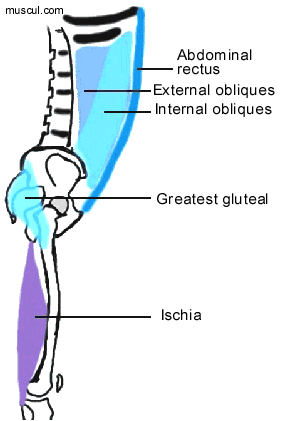MUSCLES WITH LORDOSING or DELORDOSING ACTION. |
The pelvic tilt is one of the basic movements to acquire in bodybuilding.
|
|
To understand why it is so important to know this movement, I suggest you read the following explanations. ANTEVERSION and RETROVERSION OF THE PELVIS.
The back is arched in. This natural position of the spine in man may be more or less pronounced depending on the individual. In people with excessive arching, there is a risk in the long term of pinching in the lumbar discs resulting in pinching of the sciatic nerve or the crural nerve (sciatica or cruralgia). In retroversion, the pubis is pushed forward: You soon realise that it is impossible to "live" in this position. It is simply a stance adopted when you are not moving. This position has the advantage of stacking up the lumbar vertebrae vertically and taking the weight off the intervertebral discs, thereby preventing pinching of the nuclei. |
| The RECTUS FEMORIS is a biarticular muscle, in other words it "straddles" two joints (hip and knees) such as the biceps or the long portion of the triceps. Shortening it results in downward traction of the iliac crest, which tilts the pelvis forward, thereby increasing lumbar arching. The ILIOPSOAS consists of:
the psoas minor the iliac |
 MUSCLES WITH LORDOSING ACTION. |
|
It is therefore vital to stretch the rectus femoris and the iliopsoas to avoid sciaticas. See the "Stretching" pages. As mentioned previously, however, this position cannot be kept when making any movement. The only means of prevention is to have a good abdominal girdle. It is therefore important to avoid wearing a weightlifting belt during training. You must work your abdominals as frequently as possible and as efficiently as possible. |
 MUSCLES WITH DELORDOSING ACTION.
|